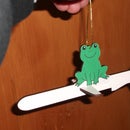Introduction: Repairing Switch on a Bicycle Light
I had a new cycle light whose switch broke after only two or three uses. Returning it to the shop might have produced a replacement, but since it looked like a design fault, I decided to repair the thing.
Also, this website is not called "returnables.com".
After a solid five minutes of work, I had not only regained the functionality of the switch, but I'd actually improved on it.
Supplies
Materials:-
A short length of very thin dowel
Some small washers
A short length of an old inner tube
Tools:-
Small saw
Sandpaper
Scissors
Step 1: Diagnosing the Problem
The switch to operate the light was a PCB mounted tactile microswitch, which was pressed upon by a small piece of rubber. This rubber cover was hinged on a very thin strip, which is what had failed.
The rubber cover fitted flush with the outside of the case, and had moulded into it a small prong which fitted through a hole in the plastic of the case to impinge on the actuator of the microswitch.
It's not entirely clear from the photographs, but the microswitch was not exactly centered underneath the hole in the case, and so whatever was going to activate the switch would also need to be constrained so that it did not slip off.
Step 2: Fabricating a Suitable Plunger
I had several lengths of wooden dowel, but none were thin enough to fit through the hole in the plastic case of the light.
The thinnest was a 4mm dowel which was only _just_ too wide, so I cut an inch of that and then carefully sanded it until it fitted, as shown in the fourth photograph.
The one inch length was far more than was needed, but there had to be enough wood to get a decent grip while sanding.
Then I cut the length of dowel down to about 7mm (1/4"), so that it would fit in the hole but protrude a little way above the case.
Step 3: Supporting Column Around the Plunger
The plan was to have a strip of rubber over the outside of the new switch, so to prevent that from pressing down on the plunger and activating the switch, and to guide the plunger and keep it vertical, we needed a short tube to go around the outside.
Lacking any suitable tube, three washers were stacked. They were chosen so that the inner diameter of the washer was just larger than the diameter of the dowel, and the thickness of the washer was such that a short stack of them came up to just a fraction less than the height of the plunger.
Step 4: Rubber Sleeve
To hold everything in place and to provide some water-proofing for the finished thing, we cut a piece of inner tube about an inch and a half (40mm) long. The tube should be of a size that it will grip the cycle light very tightly: a wide mountain-bike tyre would not hold on firmly enough and a thin racing-tyre inner tube would be stretched so tightly that it would either fail in short order, or be impossible to fit.
Once cut to length, the rubber was stretched over the body of the light, with only mild swearing, and then doubled back over itself so that the hole for the switch was exposed.
Step 5: Fitting It All Together
With the rubber stretched over the outside of the light, the dowel plunger was fitted into its hole and then the washers were slipped over it.
Lastly the rubber was unfolded, holding everything in place.
The end result is a switch button which can be found by touch in the dark, and which is sealed all around from water ingress. Frankly, this is a better solution than the one provided by the manufacturer.

Participated in the
Repair and Reuse Contest













